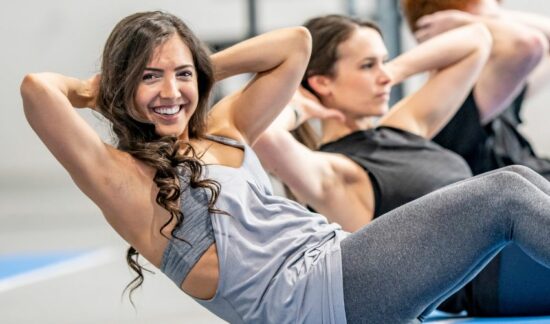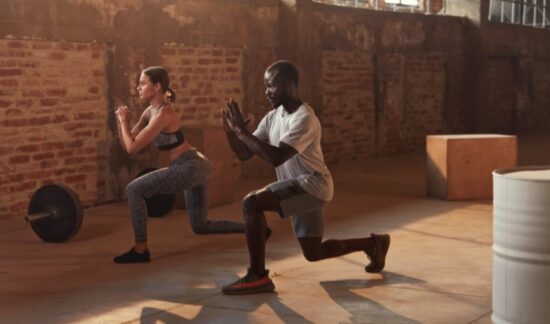The core muscles are a crucial part of our body that help us maintain proper posture, balance, and stability. These muscles are responsible for supporting the spine, pelvis, and hips, and are essential for everyday movements such as walking, bending, and lifting. Strengthening your core muscles can also help alleviate lower back pain and reduce the risk of injury during physical activities.

Abdominal Exercises
In this day and age, many people who are serious about working out strive to have abs that are as hard as rock and as defined as a six-pack.
That washboard abs look is something that everyone strives for, but which ab exercises actually work?
There are two groups of abdominal muscles to focus on: the rectus abdominis muscles (the ones you activate during regular situps, which run from your sternum to your pelvis), and the transverse abdominis muscles. Both groups of muscles travel from your sternum to your pelvis (the deepest ab muscles that wrap around the spine and help stabilize your core).
It is essential to keep in mind that you cannot eliminate fat in specific areas of your abdominals.
In order for your abdominal muscles to become visible, the layer of fat that sits directly over them must first be reduced.
The key to success is maintaining a healthy diet and engaging in cardiovascular exercise.
Perform the following nine abdominal exercises as part of your general workout routine.
Pilates.
Pilates focuses on strengthening your core muscles by having you perform exercises over and over again that target your abdominals.
For example, a modified crunch called “the 100” is performed and held for a total of one hundred counts.
In addition, there are devices, such as the reformer, that work to strengthen and stretch the muscles in your deep abdominal core.
It’s possible that the strange-looking machinery makes you feel uncomfortable.
Pilates mat sessions can now be found thankfully in a wide variety of gyms.
Because it is low-impact, Pilates is an excellent alternative if you are searching for an exercise that is mild on the joints but still provides a challenging workout for the abdominal muscles.
Then, pilates focuses on strengthening the core muscles, improving flexibility, and enhancing overall body alignment and balance. Here are the steps to follow to do Pilates:
- Warm-up: Before starting your Pilates routine, it is essential to warm up your muscles. You can do some light cardio exercises such as jogging in place, jumping jacks, or skipping.
- Get in the right position: To start, sit on a mat with your legs extended in front of you, and your feet flexed. Your arms should be extended alongside your body, with your palms facing down.
- Find your neutral spine: Engage your core muscles and find a neutral spine position by imagining a small space between your lower back and the mat.
- Start with basic exercises: Pilates has many different exercises to choose from, but it is best to start with basic ones such as the Hundred, Roll-Up, and Single Leg Stretch. You can find tutorials online or attend a Pilates class to learn the correct form.
- Focus on your breath: Pilates exercises are often coordinated with breathing. Inhale deeply through your nose and exhale through your mouth. This helps to engage your core muscles and maintain proper form.
- Move slowly: Pilates exercises are performed slowly and with control. Avoid using momentum to complete the movements, and instead focus on engaging your muscles and keeping proper form.
- Cool down: After completing your Pilates routine, take some time to cool down by stretching your muscles.
Remember to start slowly and gradually increase the intensity of your Pilates routine. You can add props such as resistance bands, balls, or blocks to increase the difficulty of the exercises. Consistency is key when it comes to Pilates, so aim to practice regularly to see results.
Plank Poses
Whether you do them in a yoga class or as part of your workout at the gym, plank positions are an excellent way to tone your abdominal muscles and give your core a flatter, more toned appearance.
The traditional form of the plank posture begins with the practitioner lying on their stomach before elevating their entire body weight onto their toes and forearms or hands in the “plank” position.
After then, you try to maintain the stance for as long as you possibly can.
You may switch things up by performing what’s called a side plank, in which you support all of your weight on one arm or hand and the sides of your feet, or you can execute back leg lifts while you’re in the standard plank stance.
Anyway, plank pose is a great exercise for strengthening your core muscles, improving your posture, and increasing your overall strength. Here are the steps to follow to do plank pose:
- Start on your hands and knees: Begin on your hands and knees with your hands shoulder-width apart and your knees hip-width apart.
- Move into the plank position: Move into the plank position by extending your legs behind you and coming up onto your toes. Your body should form a straight line from your head to your heels. Your hands should be directly under your shoulders, with your fingers spread wide for stability.
- Engage your core: Engage your core muscles by drawing your navel toward your spine. This will help to stabilize your body and prevent your lower back from sagging.
- Keep your shoulders down: Avoid shrugging your shoulders up toward your ears. Instead, keep your shoulders down and away from your ears to maintain proper form.
- Hold the position: Hold the plank position for as long as you can. Start with 30 seconds and gradually work your way up to one minute or longer as you get stronger.
- Release the position: Release the plank position by lowering your knees to the mat or by coming down onto your forearms.
Tips for plank pose:
- Keep your neck in a neutral position by looking down at the mat.
- Keep your hips level and avoid letting them sag or lift up.
- Breathe deeply and evenly throughout the exercise.
- If you have wrist pain, try doing plank pose on your forearms instead of your hands.
Plank pose is a challenging exercise, but with practice, you can improve your strength and endurance. Incorporate plank pose into your workout routine regularly to see results in your core strength and overall fitness.
Get in the Ring
Boxing requires you to use both sets of abdominal muscles, which you do via sparring and jabbing with your opponent.
Boxing is an excellent activity for improving general fitness.
When you pay attention to ensuring that your form is correct, you will notice a change in your middle.
You may get in shape by boxing at any number of gyms, and your neighborhood boxing ring may even have individual instructors available for one-on-one instruction.
However, this is a high-intensity workout routine that combines boxing-inspired movements with cardio exercises. Here are the steps to follow to do “Get in the Ring”:
- Warm-up: Before starting your workout, it is important to warm up your muscles. You can do some light cardio exercises such as jogging in place, jumping jacks, or skipping.
- Find a space: Find a spacious room or gym where you can move around freely without any obstacles.
- Get your equipment: You will need boxing gloves and a punching bag to complete the workout. Make sure the gloves fit your hands properly, and the punching bag is securely mounted.
- Start with basic boxing moves: Begin with basic boxing moves such as jabs, hooks, and uppercuts. Practice your form and technique before adding speed and power.
- Add in cardio exercises: Incorporate cardio exercises such as jumping jacks, high knees, and burpees to increase your heart rate and burn more calories.
- Create a routine: Create a routine that includes a combination of boxing moves and cardio exercises. You can find inspiration online or create your own routine that suits your fitness level and goals.
- Focus on your breathing: Breathing is important in boxing and can help you maintain your stamina. Exhale with each punch and inhale through your nose during breaks.
- Cool down: After completing your workout, take some time to cool down by stretching your muscles.
Remember to start slowly and gradually increase the intensity of your workout routine. Take breaks as needed and listen to your body. Incorporate “Get in the Ring” into your workout routine regularly to improve your cardio fitness, strength, and endurance.
Stability Boards And A Variety Of Balls
Simple exercises like pushups and squats can be made more effective by using either balls or boards, which give a technique to better work both sets of abdominal muscles.
Using these training balls and balance boards in the correct manner is of the utmost importance.
Take advantage of classes taught by qualified instructors, which are typically offered at fitness centers; if at all possible, do so.
Get Moving.
In order for your abs to become more visible, you should incorporate fat-burning cardio into your workout routine.
Choose an activity, such as jogging, walking, swimming, or spinning, that piques your interest and keeps you motivated.
According to the CDC, your goal should be either 150 minutes per week of aerobic exercise at a moderate intensity or 75 minutes of aerobic exercise at a high intensity.
Bicycle Crunches

The motion of the bicycle engages both groups of abdominal muscles.
When performed correctly, this exercise can assist in the development of a more toned abdominal region.
Bicycle crunches are a great exercise for strengthening your abdominal muscles, particularly your obliques. Here are the steps to follow to do bicycle crunches:
- Lie down: Start by lying flat on your back on a mat or comfortable surface. Bend your knees and place your feet flat on the ground.
- Put your hands behind your head: Place your hands behind your head with your elbows pointing out to the sides. Keep your shoulders relaxed and avoid pulling on your neck.
- Lift your legs: Lift your feet off the ground and bend your knees at a 90-degree angle. This will be your starting position.
- Twist your upper body: Lift your head and shoulders off the ground, and twist your upper body to the right. At the same time, bring your left knee toward your chest, and extend your right leg out straight. Reach your left elbow toward your right knee.
- Switch sides: Reverse the movement by twisting your upper body to the left, bringing your right knee toward your chest, and extending your left leg out straight. Reach your right elbow toward your left knee.
- Repeat: Continue alternating sides, moving your legs in a cycling motion while twisting your upper body.
- Breathe: Exhale as you twist and bring your knee toward your chest, and inhale as you extend your leg and return to the starting position.
Tips for bicycle crunches:
- Avoid pulling on your neck or using your hands to lift your head. Keep your hands lightly behind your head for support.
- Keep your lower back pressed into the mat to avoid straining your back.
- Focus on engaging your core muscles, particularly your obliques, as you twist your upper body and move your legs.
- Start with a low number of repetitions and gradually increase as you get stronger.
Incorporate bicycle crunches into your workout routine regularly to see results in your abdominal strength and overall fitness.
Captain’s Chair
The conventional abdominal workout known as the “crunch” is now widely regarded as being useless and as a possible source of back problems.
However, the pullup motion performed while seated in an elevated pullup chair known as a “captain’s chair” is still regarded
The Captain’s Chair is an exercise that targets the muscles in your abs, particularly your rectus abdominis, and obliques. It requires a piece of equipment called the Captain’s Chair, which is found in most gyms. Here are the steps to follow to do the Captain’s Chair exercise:
- Adjust the chair: Adjust the height of the chair so that your feet can comfortably reach the footrests. Stand on the chair and grip the handholds on either side.
- Lift your legs: Slowly lift your legs off the ground and bring your knees up toward your chest. Keep your back straight and engage your abs to support your lower back.
- Lower your legs: Slowly lower your legs back down to the starting position. Avoid swinging your legs or using momentum to lift them.
- Repeat: Complete 2-3 sets of 10-15 repetitions, taking breaks as needed.
Tips for the Captain’s Chair exercise:
- Keep your movements slow and controlled, avoiding any jerky or sudden movements.
- Focus on engaging your abs throughout the exercise to ensure that you are targeting the right muscles.
- Avoid arching your back or straining your neck. Keep your back straight and your shoulders relaxed.
- If you find the exercise too challenging, you can start by lifting one leg at a time or bending your knees slightly.
Incorporate the Captain’s Chair exercise into your workout routine regularly to improve your abdominal strength and overall fitness.
TorsoTwist
Standing is required for this particular abdominal exercise.
The torso twist is a simple yet effective exercise for strengthening your oblique muscles, which are located on the sides of your waist. Here are the steps to follow to do the torso twist:
- Stand up straight: Stand up straight with your feet shoulder-width apart.
- Extend your arms: Extend your arms out in front of you at shoulder height, with your palms facing each other.
- Twist your torso: Twist your torso to the right, pivoting on your left foot. Keep your arms straight and parallel to the ground as you twist.
- Twist to the other side: Return to the starting position and then twist your torso to the left, pivoting on your right foot. Keep your arms straight and parallel to the ground as you twist.
- Repeat: Complete 2-3 sets of 10-15 repetitions, taking breaks as needed.
Tips for the torso twist:
- Keep your movements slow and controlled, avoiding any jerky or sudden movements.
- Focus on engaging your oblique muscles as you twist your torso to each side.
- Keep your feet firmly planted on the ground to maintain your balance.
- If you find the exercise too challenging, you can start by holding a light weight or resistance band in your hands.
Incorporate the torso twist into your workout routine regularly to improve your oblique strength and overall fitness. It is a great exercise to add to your core workout routine, and can help you achieve a stronger and more toned waistline.
Lunges.

Lunges are great for toning your entire body, but they are especially beneficial for strengthening your lower body muscles, including your glutes, quadriceps, and hamstrings. The muscles that make up your “core,” even though you would not think of them as an abdominal workout.
Here are the steps to follow to do lunges:
- Stand up straight: Stand up straight with your feet hip-width apart.
- Step forward: Take a large step forward with your right foot, landing on the heel first and then rolling onto the ball of your foot.
- Lower your body: Lower your body by bending your right knee and dropping your left knee toward the ground. Keep your back straight and your core engaged.
- Keep your balance: Keep your right knee in line with your right ankle and ensure that your left knee is hovering just above the ground. Your weight should be evenly distributed between both feet.
- Return to starting position: Push through your right heel to return to the starting position.
- Repeat on other side: Repeat the movement on the other side, stepping forward with your left foot.
- Repeat: Complete 2-3 sets of 10-15 repetitions on each leg, taking breaks as needed.
Tips for lunges:
- Keep your movements slow and controlled, avoiding any jerky or sudden movements.
- Keep your core engaged throughout the exercise to maintain good form and balance.
- Avoid letting your front knee go beyond your toes.
- Keep your shoulders relaxed and avoid tensing up your upper body.
- If you find the exercise too challenging, you can start by doing reverse lunges, where you step backward instead of forward.
Incorporate lunges into your workout routine regularly to improve your lower body strength and overall fitness.
First, stand with your feet spaced out to the width of your hips, and then take one step forward into a lunge position.
Make sure that your rear knee is up approximately 3 inches off the ground at all times.
To make the workout a little more challenging, you might add some light dumbbells.
Total Body Fitness and Health
When it comes to your abdominal muscles, keep in mind that it is not all about doing spot-training.
Maintain a healthy balance between calories consumed and burned by participating in regular cardiovascular exercise.
As you work toward achieving a flattering stomach, don’t forget about the rest of your body.
FAQs
The sort of fat that your body accumulates in your abdominal cavity and all around your intestines is called visceral fat. Its primary function is to prevent individuals from falling victim to a flat bell. Genetics may play a role in determining some aspects of it.
